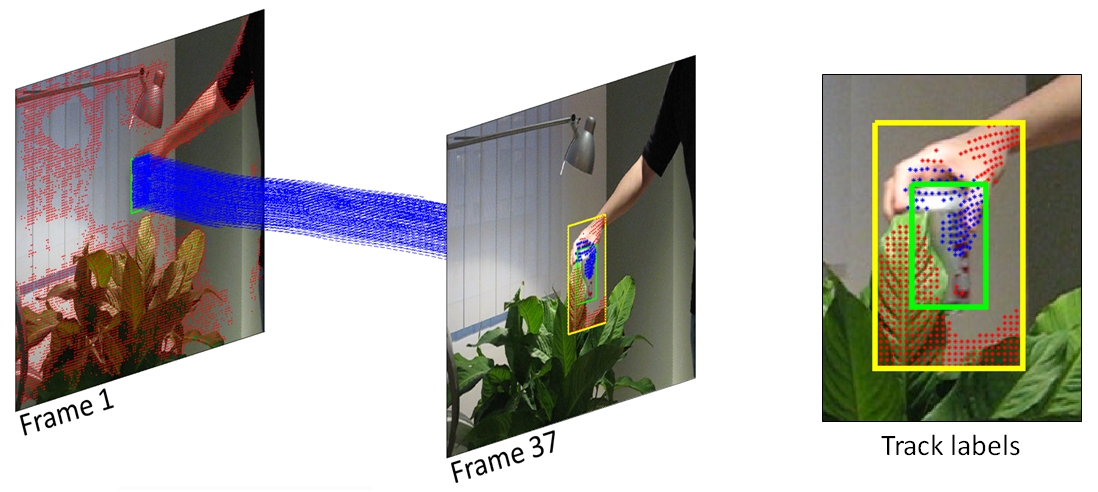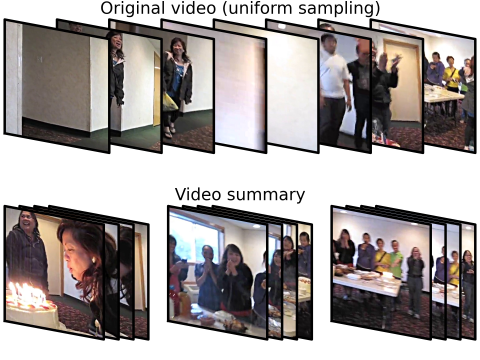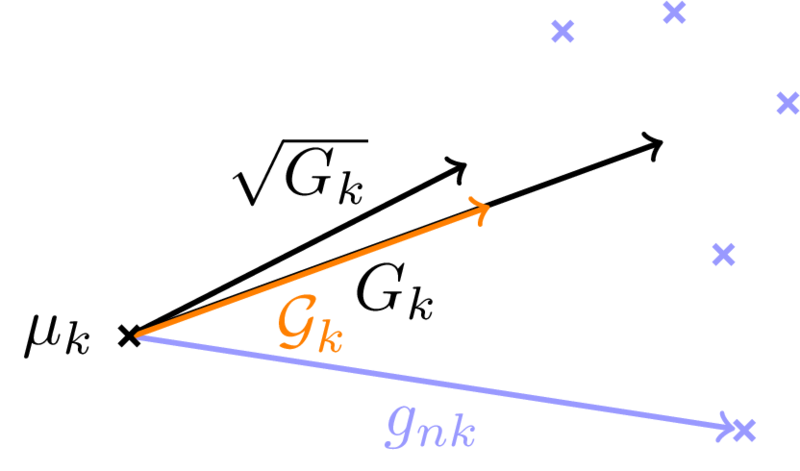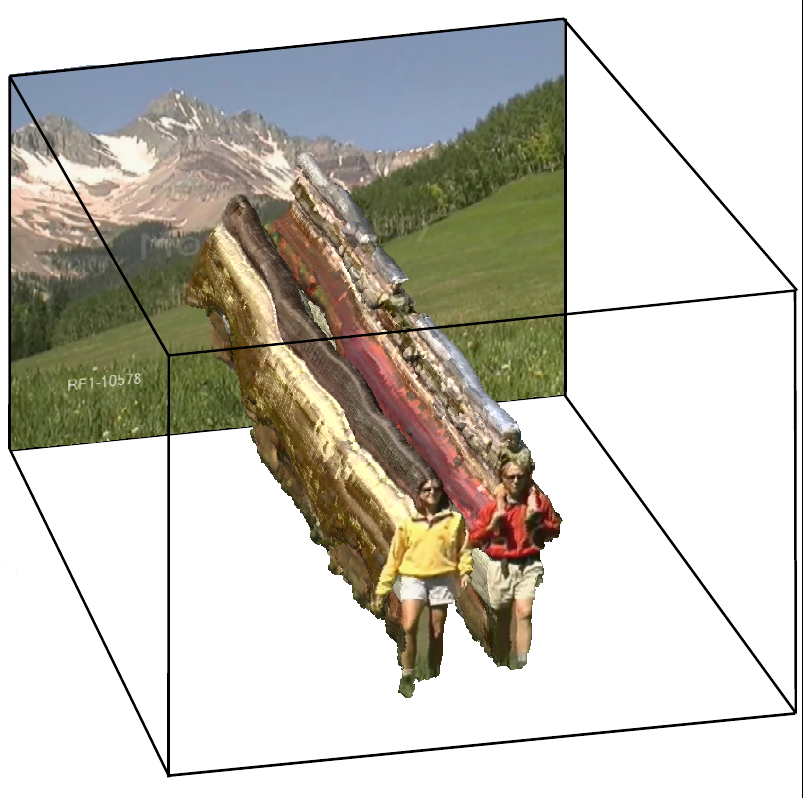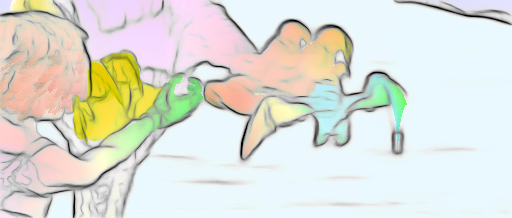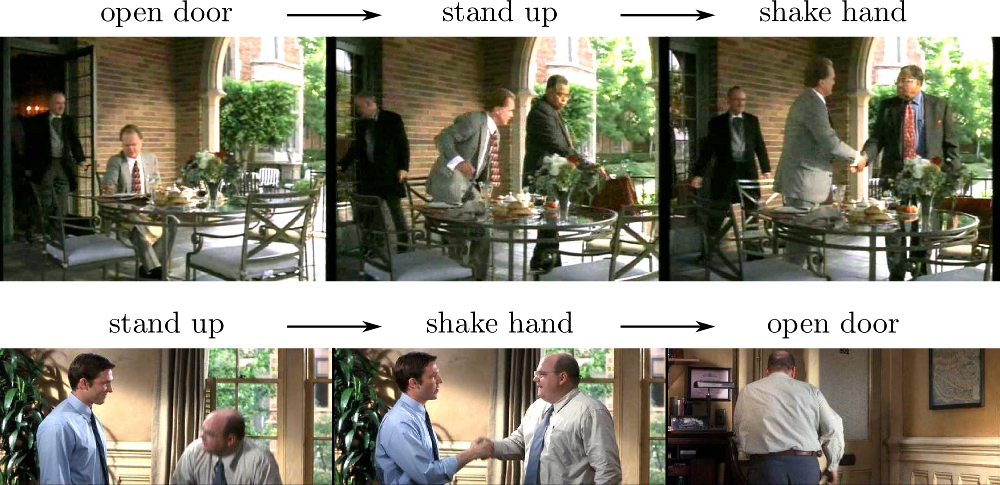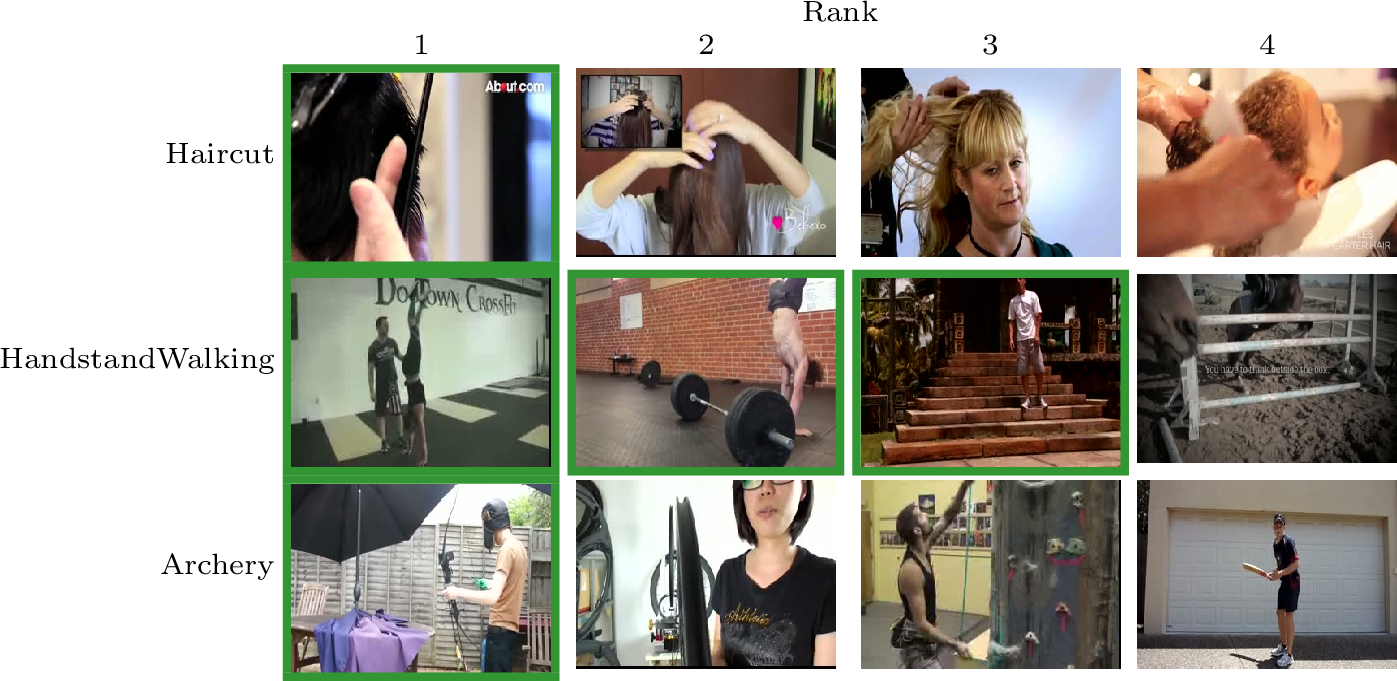Section: New Results
Recognition in video
Occlusion and Motion Reasoning for Long-Term Tracking
Participants : Yang Hua, Karteek Alahari, Cordelia Schmid.
Object tracking is a reoccurring problem in computer vision. Tracking-by-detection approaches, in particular Struck, have shown to be competitive in recent evaluations. However, such approaches fail in the presence of long-term occlusions as well as severe viewpoint changes of the object. In this paper we propose a principled way to combine occlusion and motion reasoning with a tracking-by-detection approach. Occlusion and motion reasoning is based on state-of-the-art long-term trajectories which are labeled as object or background tracks with an energy-based formulation. The overlap between labeled tracks and detected regions allows to identify occlusions. The motion changes of the object between consecutive frames can be estimated robustly from the geometric relation between object trajectories. If this geometric change is significant, an additional detector is trained. Experimental results show that our tracker obtains state-of-the-art results and handles occlusion and viewpoints changes better than competing tracking methods. This work corresponds to the publication [15] and is illustrated in Figure 10 .
|
Category-Specific Video Summarization
Participants : Danila Potapov, Matthijs Douze, Zaid Harchaoui, Cordelia Schmid.
In large video collections with clusters of typical categories, such as “birthday party” or “flash-mob”, category-specific video summarization can produce higher quality video summaries than unsupervised approaches that are blind to the video category. Given a video from a known category, our approach published in [20] first efficiently performs a temporal segmentation into semantically-consistent segments, delimited not only by shot boundaries but also general change points. Then, equipped with an SVM classifier, our approach assigns importance scores to each segment. The resulting video assembles the sequence of segments with the highest scores, as shown in Figure 11 . The obtained video summary is therefore both short and highly informative. Experimental results on videos from the multimedia event detection (MED) dataset of TRECVID'11 show that our approach produces video summaries with higher relevance than the state of the art.
Efficient Action Localization with Approximately Normalized Fisher Vectors
Participants : Dan Oneata, Jakob Verbeek, Cordelia Schmid.
The Fisher vector (FV) representation is a high-dimensional extension of the popular bag-of-word representation. Transformation of the FV by power and normalizations has shown to significantly improve its performance, and led to state-of-the-art results for a range of image and video classification and retrieval tasks. These normalizations, however, render the representation non-additive over local descriptors. Combined with its high dimensionality, this makes the FV computationally expensive for the purpose of localization tasks. In [18] we present approximations to both these normalizations (see Figure 12 ), which yield significant improvements in the memory and computational costs of the FV when used for localization. Second, we show how these approximations can be used to define upper-bounds on the score function that can be efficiently evaluated, which enables the use of branch-and-bound search as an alternative to exhaustive sliding window search. We present experimental evaluation results on classification and temporal localization of actions in videos. These show that the our approximations lead to a speedup of at least one order of magnitude, while maintaining state-of-the-art action recognition and localization performance.
|
Spatio-Temporal Object Detection Proposals
Participants : Dan Oneata, Jakob Verbeek, Cordelia Schmid, Jerome Revaud.
Spatio-temporal detection of actions and events in video is a challenging problem. Besides the difficulties related to recognition, a major challenge for detection in video is the size of the search space defined by spatio-temporal tubes formed by sequences of bounding boxes along the frames. Recently methods that generate unsupervised detection proposals have proven to be very effective for object detection in still images. These methods open the possibility to use strong but computationally expensive features since only a relatively small number of detection hypotheses need to be assessed. In [17] we make two contributions towards exploiting detection proposals for spatio-temporal detection problems. First, we extend a recent 2D object proposal method, to produce spatio-temporal proposals by a randomized supervoxel merging process (see Figure 13 ). We introduce spatial, temporal, and spatio-temporal pairwise supervoxel features that are used to guide the merging process. Second, we propose a new efficient supervoxel method. We experimentally evaluate our detection proposals, in combination with our new supervoxel method as well as existing ones. This evaluation shows that our supervoxels lead to more accurate proposals when compared to using existing state-of-the-art supervoxel methods.
|
EpicFlow: Edge-Preserving Interpolation of Correspondences for Optical Flow
Participants : Revaud Jerome, Weinzaepfel Philippe, Harchaoui Zaid, Cordelia Schmid.
We propose a novel approach [29] for optical flow estimation, targeted at large displacements with significant occlusions. It consists of two steps: i) dense matching by edge-preserving interpolation from a sparse set of matches; ii) variational energy minimization initialized with the dense matches. The sparse-to-dense interpolation relies on an appropriate choice of the distance, namely an edge-aware geodesic distance. This distance is tailored to handle occlusions and motion boundaries (see Figure 14 ), two common and difficult issues for optical flow computation. We also propose an approximation scheme for the geodesic distance to allow fast computation without loss of performance. Subsequent to the dense interpolation step, standard one-level variational energy minimization is carried out on the dense matches to obtain the final flow estimation. The proposed approach, called Edge-Preserving Interpolation of Correspondences (EpicFlow) is fast and robust to large displacements. It significantly outperforms the state of the art on MPI-Sintel and performs on par on KITTI and Middlebury.
|
Weakly Supervised Action Labeling in Videos Under Ordering Constraints.
Participants : Piotr Bojanowski [Willow team, Inria] , Rémi Lajugie [Willow team, Inria] , Francis Bach [Sierra team, Inria] , Ivan Laptev [Willow team, Inria] , Jean Ponce [Willow team, Inria] , Cordelia Schmid, Josef Sivic [Willow team, Inria] .
Suppose we are given a set of video clips, each one annotated with an ordered list of actions, such as “walk” then “sit” then “answer phone” extracted from, for example, the associated text script. See Fig. 15 for an illustration. In this work [8] , we seek to temporally localize the individual actions in each clip as well as to learn a discriminative classifier for each action. We formulate the problem as a weakly supervised temporal assignment with ordering constraints. Each video clip is divided into small time intervals and each time interval of each video clip is assigned one action label, while respecting the order in which the action labels appear in the given annotations. We show that the action label assignment can be determined together with learning a classifier for each action in a discriminative manner. We evaluate the proposed model on a new and challenging dataset of 937 video clips with a total of 787720 frames containing sequences of 16 different actions from 69 Hollywood movies.
|
Mixing Body-Part Sequences for Human Pose Estimation
Participants : Cherian Anoop, Mairal Julien, Alahari Karteek, Schmid Cordelia.
This work [11] presents a method for estimating articulated human poses in videos. We cast this as an optimization problem defined on body parts with spatio-temporal links between them. The resulting formulation is unfortunately intractable and previous approaches only provide approximate solutions. Although such methods perform well on certain body parts, e.g., head, their performance on lower arms, i.e., elbows and wrists, remains poor. We present a new approximate scheme with two steps dedicated to pose estimation. First, our approach takes into account temporal links with subsequent frames for the less-certain parts, namely elbows and wrists. Second, our method decomposes poses into limbs, generates limb sequences across time, and recomposes poses by mixing these body part sequences (See Figure 16 for an illustration). We introduce a new dataset "Poses in the Wild", which is more challenging than the existing ones, with sequences containing background clutter, occlusions, and severe camera motion. We experimentally compare our method with recent approaches on this new dataset as well as on two other benchmark datasets, and show significant improvement.
|
The LEAR Submission at Thumos 2014
Participants : Dan Oneata, Jakob Verbeek, Cordelia Schmid.
In [28] we describe the submission of our team to the THUMOS workshop in conjunction with ECCV 2014. Our system is based on Fisher vector (FV) encoding of dense trajectory features (DTF), which we also used in our 2013 submission. The dataset is based on the UCF101 dataset, which is currently the largest action dataset both in terms of number of categories and clips, with more than 13000 clips drawn from 101 action classes. This year special attention was paid to classification of uncropped videos, where the action of interest appears in videos that contain also non-relevant sections. This year's submission additionally incorporated static-image features (SIFT, Color, and CNN) and audio features (ASR and MFCC) for the classification task. For the detection task, we combined scores from the classification task with FV-DTF features extracted from video slices. We found that these additional visual and audio feature significantly improve the classification results. For localization we found that using the classification scores as a contextual feature besides local motion features leads to significant improvements. In Figure 17 we show the middle frame from the top four ranked videos corresponding to the three hardest classes (as evaluated on the validation data). Our team has ranked second on the classification challenge (out of eleven teams) and first on the detection challenge (out of three teams).
|
The LEAR Submission at TrecVid MED 2014
Participants : Matthijs Douze, Dan Oneata, Mattis Paulin, Clément Leray, Nicolas Chesneau, Danila Potapov, Jakob Verbeek, Karteek Alahari, Zaid Harchaoui, Lori Lamel [Spoken Language Processing group, LIMSI, CNRS] , Jean-Luc Gauvain [Spoken Language Processing group, LIMSI, CNRS] , Christoph Schmidt [Fraunhofer IAIS, Sankt Augustin] , Cordelia Schmid.
In [26] we describe our participation to the 2014 edition of the TrecVid Multimedia Event Detection task. Our system is based on a collection of local visual and audio descriptors, which are aggregated to global descriptors, one for each type of low-level descriptor, using Fisher vectors. Besides these features, we use two features based on convolutional networks: one for the visual channel, and one for the audio channel. Additional high-level features are extracted using ASR and OCR features. Finally, we used mid-level attribute features based on object and action detectors trained on external datasets. In the notebook paper we present an overview of the features and the classification techniques, and experimentally evaluate our system on TrecVid MED 2011 data.
We participated in four tasks, which differ in the amount of training videos for each event (either 10 or 100), and the time that is allowed for the processing. For the 20 pre-specified events several weeks are allowed to extract features, train models, and to score the test videos (which consisted of 8,000 hours of video this year). For the 10 ad-hoc events, we only have five days to do all processing. Across the 11 participating teams, our results ranked first for the 10-example ad-hoc task, and fourth and fifth place for the other tasks.



